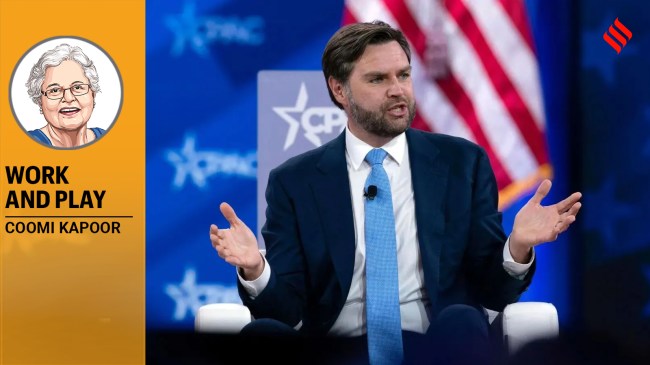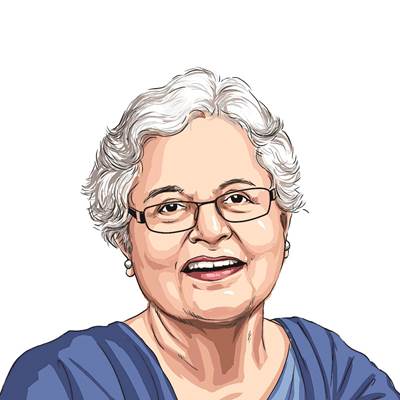Opinion Inside Track: Work and Play
US V-P J D Vance’s recent visit to India, accompanied by US government office-bearers, including Ricky Gill, senior director, South and Central Asia, National Security Council, was a mix of official and unofficial engagements.
 The MEA, while releasing the V-P’s programme in India, left most of his activities in Jaipur and Agra blank, suggesting that the US Embassy in New Delhi be contacted for information.
The MEA, while releasing the V-P’s programme in India, left most of his activities in Jaipur and Agra blank, suggesting that the US Embassy in New Delhi be contacted for information. US V-P J D Vance’s recent visit to India, accompanied by US government office-bearers, including Ricky Gill, senior director, South and Central Asia, National Security Council, was a mix of official and unofficial engagements. India was disconcerted by the trip’s timing, which was to discuss tariff tensions, since PM Modi was scheduled to leave India a day after Vance’s arrival on April 21 for a scheduled visit to Saudi Arabia to discuss the modalities of the first meeting of the India-Saudi Strategic Partnership Council. The MEA, while releasing the V-P’s programme in India, left most of his activities in Jaipur and Agra blank, suggesting that the US Embassy in New Delhi be contacted for information. In Jaipur, the Vances stayed at the exclusive Rambagh Palace and tourists who had already booked were asked to vacate for security reasons. The only guests permitted to remain was a small cloistered wedding party. The Rajasthan media speculated that the Vances might also be attending the wedding. Although Vance and his wife Usha were visiting India for the first time since their marriage a decade ago, they did not spend any time in South India, although Usha is the daughter of Telugu immigrants from AP. In fact, a nonagenarian aunt in Visakhapatnam, an eminent professor, was unaware of the impending visit until informed by a local official.
Reddy Hospitality
CM Revanth Reddy ordered Telangana officials to pull out all the stops for the global meet organised by the Samruddha Bharat Foundation in the state recently. Telangana provided the infrastructure and funds for the hospitality extended to 450 delegates. Officials were puzzled why a meet on global democracy attended by vague foreigners, many of whom did not have specific credentials, would help boost investment in the state. Reddy was keen to please the foundation’s executive trustee Gurdeep Sappal, who is attached to Congress chief Mallikarjun Kharge’s office and rumoured to be close to the Congress high command. A day before the meet wound up, Reddy discovered, to his horror, that the expected high-profile guests had bailed out. Kharge and Priyanka Gandhi stayed away, and a rather reluctant Rahul Gandhi was finally persuaded to come after his former mentor in the US, Sam Pitroda, spoke to him. Sappal’s group is meant to be a Congress think tank counter to the BJP’s Vivekananda Foundation, and most of the delegates were certainly not potential investors. Ironically, when in neighbouring Karnataka, Congress CM Siddaramaiah held an official foreign investors’ summit in February, no one from the Gandhi family attended when Defence Minister Rajnath Singh inaugurated it.
Getting Clearance
RSS chief Mohan Bhagwat’s visit on Tuesday to PM Modi’s residence was very significant. A senior minister escorted Bhagwat from the RSS office in Jhandewalan to Lok Kalyan Marg. Modi was keen to ensure the BJP was on the same page as the RSS in view of public differences during the Lok Sabha campaign. The discussion was more about the caste census than the proposed response to the Pahalgam attack. Incidentally, the stalemate in announcing a new BJP chief reflects the ongoing power tussle between the RSS and the BJP.
Sensible Solution
The Modi government is sitting on Pandora’s box on the issue of a delimitation exercise after the impending census. Previous governments had succeeded in deferring the contentious exercise. In 1976, an Emergency in place and PM Indira Gandhi pushed through the 42 Amendment since the main Opposition was in jail. In 2002, then PM Atal Bihari Vajpayee artfully dodged the exercise. He called a Cabinet meeting to discuss a National Population Policy. At the fag end, he got into a huddle with L K Advani and M M Joshi, and simply announced that additionally the government would defer delimitation till 2026, a matter unrelated to the actual agenda. Cabinet clearance for the 84th amendment was done so swiftly that the RSS and others opposed had no time to react. Today, deferring delimitation can no longer be done under cover and a viable formula with the consent of the aggrieved states, mostly from the south, has to be arrived at. Former CEC N Gopalaswami suggests that an Amendment be passed freezing representation in Parliament. His point is that MPs are expected to concern themselves largely with policy issues, while localised problems concerning the constituency are dealt with by the local elective bodies. Whether an MP represents 10, 15 or 18 lakh constituents, he is physically incapable of handling their demands. Adding 200-odd more MPs to the existing strength of the Lok Sabha would be unwieldy and unproductive. The only advantage of more MPs is the edge it would provide to more populous states in electing a PM.






